Why You Need to Visit the Fez Medina in Morocco
Disclaimer: This post may contain affiliate links, which means I may earn a small commission if you make a purchase at no additional cost to you. I only recommend products and services that I would use myself and all opinions expressed here are my own. You can read my full privacy policy here.
The Fez Medina in my opinion is probably the most underrated and fascinating place to visit in Morocco. It an imperial city, where ancient charm and bustling energy fuse into an unforgettable urban tapestry in a beauitful medina. If you’re looking somewhere which combines rich culture, authentic experiences and some excellent gastonomy, the Fez Medina is the place to visit! Below is a list of the reasons why you need to visit Fez and what to do in the medina, based on my own recent trip.
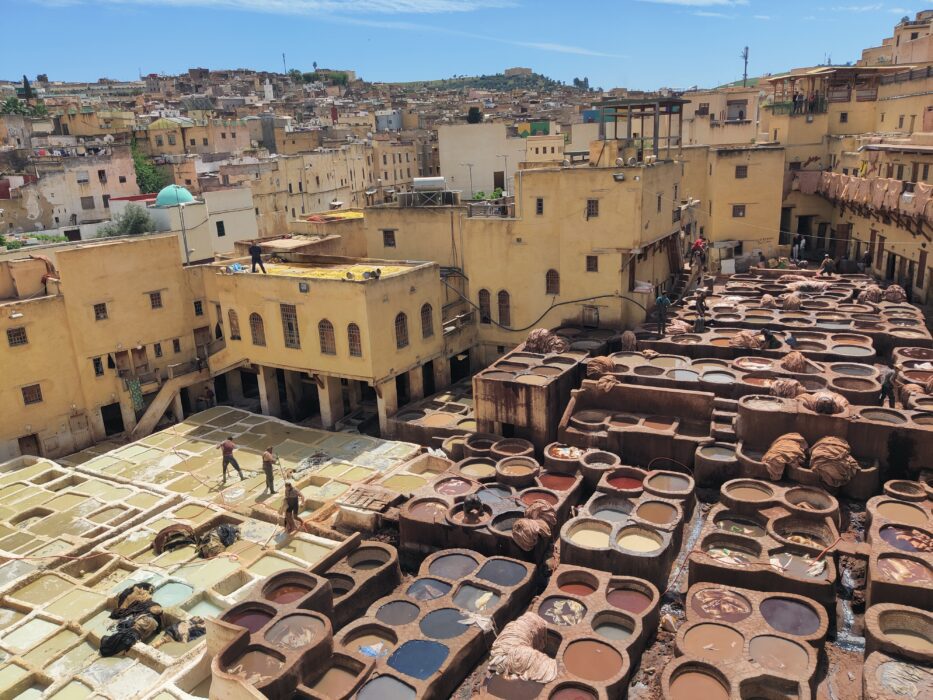
Visit the Chouara Tannery in Fez Medina
Location: Northeast part of Fez Mezdina, entrance is through shops selling leather goods.
Admission: Free, but tips for guides or entrance fees for terrace views might apply
Opening Hours: Generally open from 9 AM – 6 PM, but hours can vary
A visit to the iconic Chouara Tannery a must when in the Fez Medina —a raw, captivating experience. This is something I strongly recommend you incorporate into your itinerary. It is a little bit of work to find the perfect viewpoint for the tannery, but it was probably the most memorable part of my time in Fez!
Itinerary tips: A little planning will be in order before you go so that you can reach the best photo spots for the birds-eye view of the tannery. The bird eye view is truely the most iconic view to wtiness in the Fez Medina, in my opinion and a highlight of our time in Fez city in Morocco! We reached the bird’s eye viewpoint, with the help of our walking tour guide from Free Fez Walking Tours. However you can reach the viewpoint on your own through certain leather shops as detailed out in my Chouara Tannery blog post here.
Tips for Visiting the Chouara Tannery
Most shops nowdays expect some small payment if you are entering just to access their viewpoint, so make sure to have some small notes on hand for this. One thing I also noticed was that the tannery surrounds have a distinct smell. This is from the animals skins being processed for leather, due to the traditionally employed methods in the tanning process. The smell definitely hit me as we approached the tannery area! However as we entered the leather shops to get to the view upstairs, the owner was kindly handing our fresh mint sprigs to help with the odour.
If you are venturing out on your own without a tour, I would highly suggest you go in the morning hours. This is most definitely the best time, when you get to see the tannery in full swing!
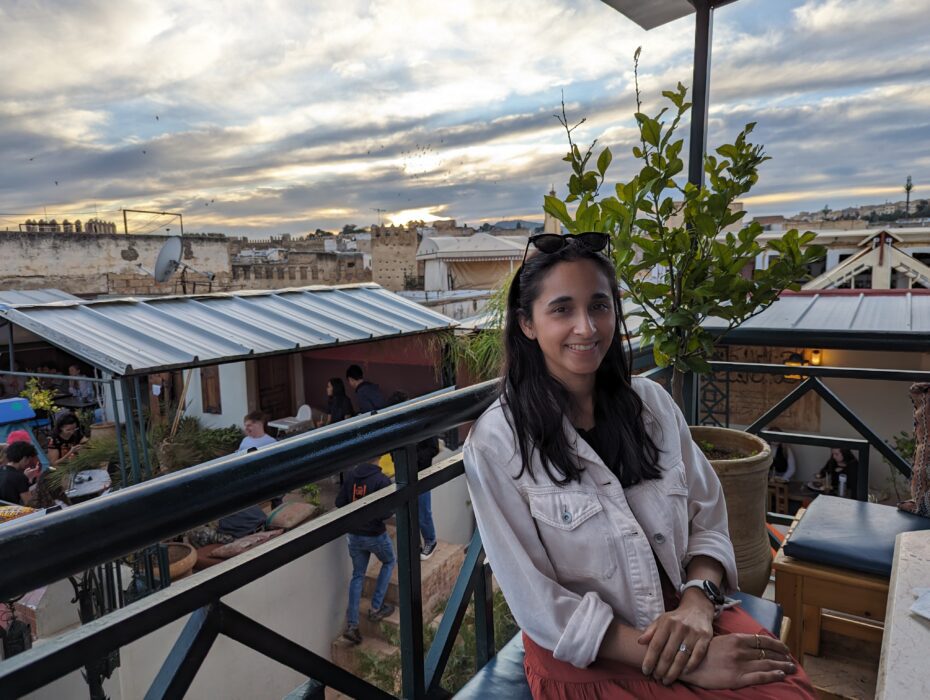
Jardin Jnan Sbil: Lush Hideaway in the Fez Medina
Location: A 10-minute walk from Fes el Bali
Admission: Free
Opening Hours: Daily, 8 AM – 6 PM
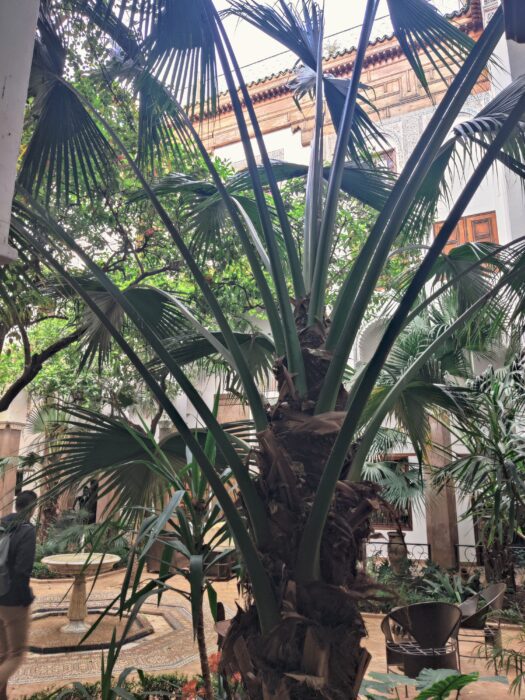
After the beautiful chaos of the Medina, the Jardin Jnan Sbil is the perfect stop. A few steps away from the beating heart of the city, this garden sanctuary gives nature an ideal pit stop to chill. All the more reason entry is free and it’s an ideal option for budget-conscious explorers who want to take in the beauty without spending.
Visits during springtime are magical, since the gardens practically come alive with a visual spectacle of blooms. Imagine a festival of colors organized by nature for your Instagram stories. There is a kind of serenity in the air that invites you to slow down. I recommend going when the weather is sunny ansd warm, perhaps after exploring the medina when you need a quiet break.
Explore the Fez Medina’s labyrith of streets
- Location: Fes el Bali, Medina
- Best time to visit: Late morning to early afternoon
- No tickets required
- Tips: Cash is king for haggling and purchases
The Fez Medina is one of the largest car-free urban areas in the world. The narrow streets can’t accommodate vehicles, making donkeys, mules, and foot traffic the primary means of transport.
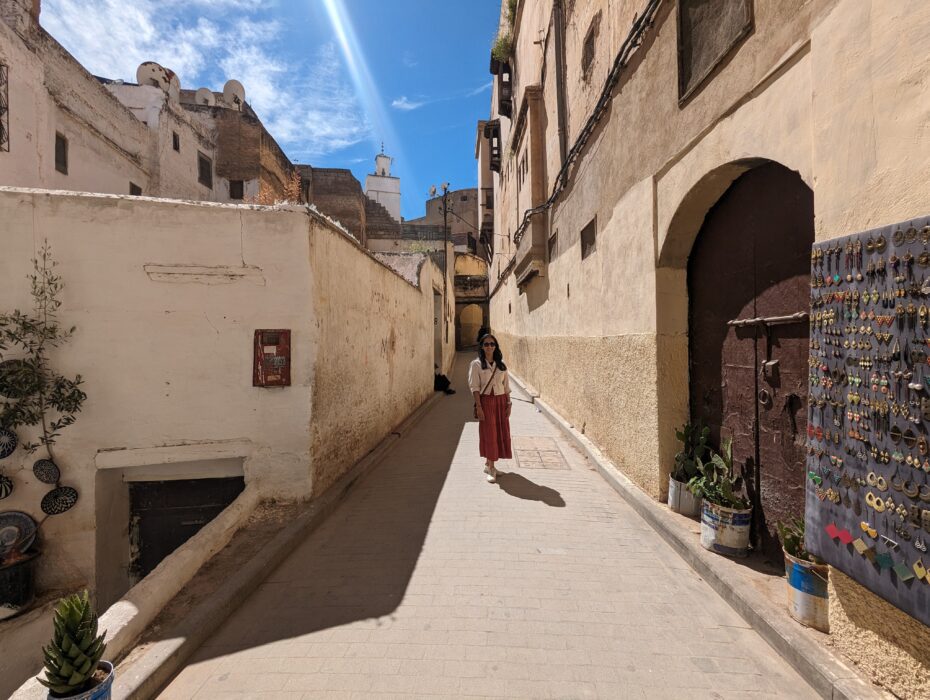
With over 9,000 alleys, navigating the Medina can be a complex but enchanting experience. We embarked on exploring the medina our first morning in Fes. With its bustling lanes, the air was buzzing with a vibrant and aroma of spices and sweet pastries all around.
Start your journey with a game plan as these markets are a maze of wonders waiting to be discovered. We found that similar shops are clustered together. For example, there are dedicated streets for leather goods, morocoon lamps, herbal and tea vendors, sweet pastries carts.
Make sure to kick off your bargaining with a friendly smile and aim for half the initial asking price—it’s not just shopping, it’s an experience. If you’re on hunt for the perfect Instagram backdrop, the markets are a goldmine. Every corner tells a story, from ancient doorways to stalls overflowing with colorful ceramics. Just ask before snapping pictures.

Visiting Bab Boujloud – The Gateway to Fez’ Medina
Location: Fez Medina entrance
Tickets: No entrance fee
Stepping through Bab Boujloud, the iconic blue gate marking the entrance to Fez’s historic heart, feels like stepping back in time. First things first, this spot is a must-see, and the best part? It’s completely free to explore. Aim for a late afternoon visit—the light is just magic then, casting the perfect glow for those epic photos.
Once you’re there, the contrast between the blue on the exterior and the green on the inside—colors representing Fez and Islam—really pops. It’s not just a gate; it’s a piece of art, telling stories of the city’s rich history and culture. Take a moment to appreciate the intricate tile work; it’s seriously impressive.
Around the gate, the vibe is buzzing. Street vendors, cafes, and shops line the area, making it the perfect spot to grab a mint tea and people-watch. Speaking of shopping, this is your gateway to some serious retail therapy in the medina, from leather goods to traditional ceramics.

For those looking to snap that iconic shot of Bab Boujloud, cross the street to Café Clock. The view from their rooftop is unmatched, giving you a full, unobstructed view of the gate’s grandeur. Plus, their food is a delightful fusion of traditional and modern—definitely try the camel burger if you’re feeling adventurous.
Visiting Bou Inania Madrasa in Fez
Tickets: Approximately 20 DHS or $2
Opening Hours: 9 AM to 6 PM daily, however closed during prayer times during Ramadan
Location: Central Fez, within walking distance from the Medina
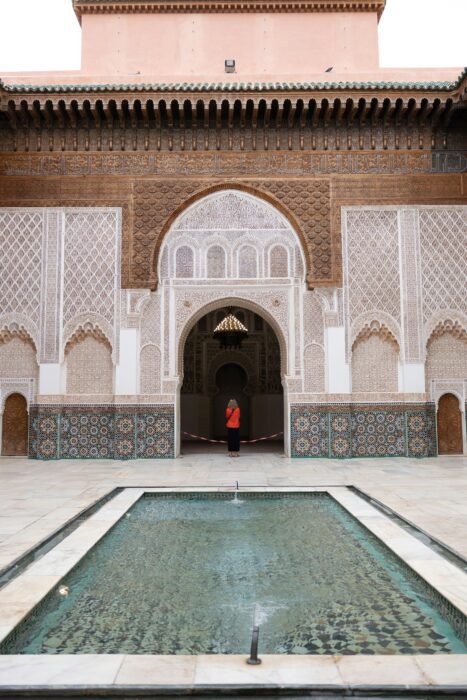
Stepping into Bou Inania Madrasa isn’t just a visit; it’s a journey back in time. This stunning example of Marinid architecture is a must-see in the Fez Medina, with its intricately carved wood, stucco, and tile work that literally dazzles.
Located smack dab in the heart of Fes just a short walk fro the main Fez Medina’s entrance, this was our first stop once in the Medina. The madrasa itself offers a rare peek into Islamic educational history, making it not just a feast for the eyes but a dive into rich cultural waters.
The place isn’t massive, so an 30 mins is plenty to soak in the beauty without rush. The medina’s bustling streets area sensory overload so this medina serene central courtyard was a welcome break. It’s one of the few religious buildings in Morocco open to non-Muslim visitors, giving a unique glimpse into the spiritual heritage of the city.
Al Attarine Madrasa
Location: Near the famous Al-Karaouine Mosque and University, within the Fes el Bali district
Tickets: Approximately $3
Opening Hours: 9 AM – 6 PM daily
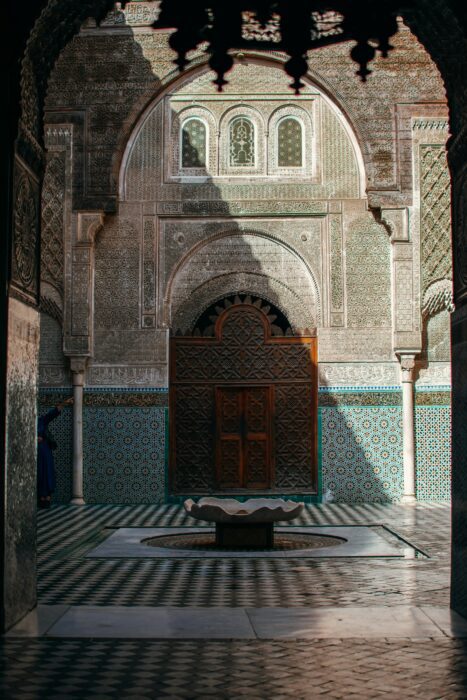
Tucked away in the heart of the medina, Al Attarine Madrasa is a hidden gem that totally deserves a spot on your itinerary. This place isn’t just another historical site; it’s a masterpiece of Marinid architecture that will take your breath away. Imagine intricately carved cedarwood, stunning zellij tilework, and that serene courtyard vibe that makes you feel like you’ve stepped back in time. Here’s the scoop: it’s super close to the famous Qarawiyyin Mosque, making it easy to tick off two must-see spots in one go.
We got here at 11am and found the place reasonably empty with a few visitors and locals around. Just make sure you look up prayer times beforehand or ask your Riad/ hotel for guidance on this as you will want to plan any Madrasda visits before and after these. Entrance is typically reserved for locals during these times.
Exploring the Al-Karaouine Mosque and University in Fez
Location: Heart of Fez Medina
Viewing Tips: Non-Muslims can admire the exterior and the university’s influence in the surrounding area
Nearby Attractions: Medersa el-Attarine, with a small entry fee of about $2
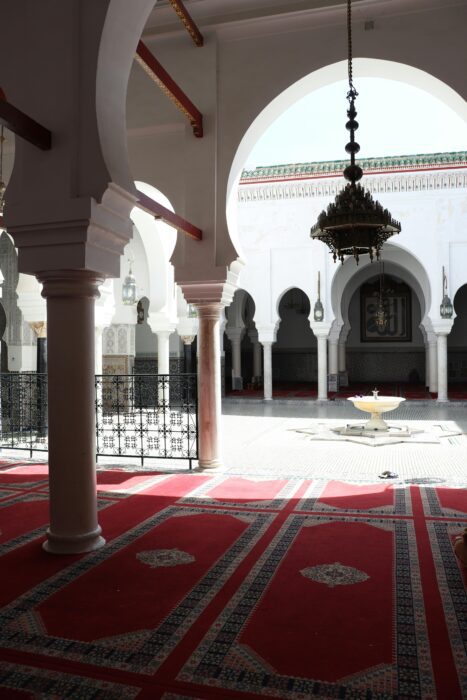
Nestled within the labyrinth of Fes el Bali, the Al-Karaouine Mosque and University stand as a testament to the city’s rich historical tapestry. Founded in 859 by Fatima al-Fihri, a woman who was pioneering in her commitment to education and religion, this institution is recognized by UNESCO and many scholars as the oldest continuously operating university in the world.
Although the doors of the mosque itself are not open to non-Muslim visitors, the surrounding area offers plenty to admire and learn. The architecture, visible from the outside, showcases classic Islamic design, inviting onlookers to appreciate its historical significance and beauty.
Experience a traditional Hamman Spa and Massage
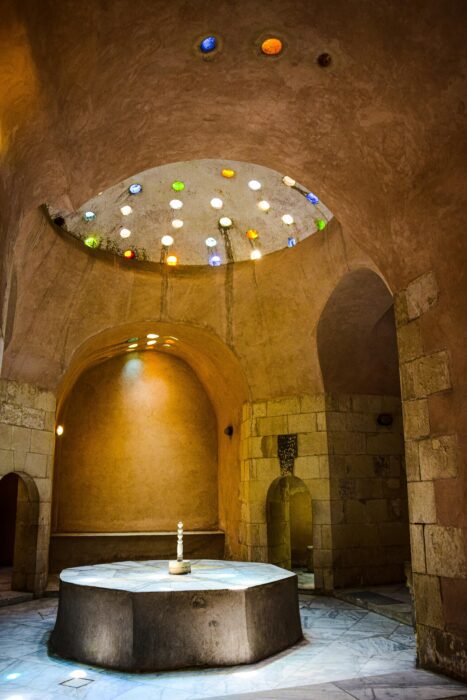
No visit to Fez Medina in Morocco would be complete without experience a traditional Moroccon Hamman and Spa. Spa Laaroussa, located inside the Medina as part of Riad Larroussa is a top rated traditional Hamman experience. Given its popularity in recent times I booked about a week in advance of my visit.
The cost is about 350 for a traditional Hamman and scrub and 380 for a massage. I would highly recomend this if you need a break from the hustle and buslte of the medina for a few hours and I found the experience 10/10. Check out our detailed blog post on the Laaroussa Hamman and Spa experience here.
Practical Tips for Navigating the Fez Medina
No matter how great at navigating you are, you are bound to get a little lost in labyrith of alleys in the Fez medina, and this is not necessarily a bad thing as I found out. Nonetheless, these are my practical tips for visting the Medina.

- Dress Smart: Comfort is key. Opt for layers and breathable fabrics to tackle the varying temperatures, especially if you’re wandering from dawn till dusk. And shoes? Closed-toe, comfy ones are your best friends on those cobblestone paths.
- Stay Connected: Grab a local SIM card at the airport or any main square. It’s a lifesaver for maps and quick translations. Plus, staying Insta-ready requires a solid data plan, right?
- Cash is King: While cards are gaining traction, many places in the Medina still run on cash. Keep smaller bills on hand for smooth transactions, from haggling in the markets to tipping guides.
- Water Wisdom: Stick to bottled water to keep those travel bugs at bay. You’ll find it everywhere, so staying hydrated is a breeze.
- Navigating the Medina: The maze-like Medina is part of Fez’s charm, but it’s easy to get turned around. Download an offline map or invest in a good old paper one. Sometimes, going analog just adds to the adventure.
- Market Haggling: Haggling in the markets is expected. Start at about half the asking price and enjoy the banter. It’s part of the experience and can also land you some great deals.
- Safety First: The Fez medina in Morocco is relatively safe, but like any busy city, keep an eye on your belongings. A crossbody bag worn in front secures your essentials and lets you roam worry-free.
- Language Basics: A few phrases in Arabic or French go a long way. “Shukran” (thank you) and “La, shukran” (no, thank you) are golden, especially to politely decline persistent vendors.
- Timing Your Visit: Early morning or late afternoon are prime times to explore Fes Medina. Beat the crowds, catch the soft light for photos, and enjoy a more laid-back vibe.
Best time to Visit Fez in Morocco
- Spring (March to May): Expect temperatures around 65°F to 75°F (18°C to 24°C). This is prime time for comfort and color in Fez, with the weather being pleasantly warm, ideal for all-day exploration without overheating. Though popular, it’s wise to book accommodations ahead due to increased demand, particularly around local festivals.
- Fall (September to November): Offering a climate similar to spring, with daytime temperatures hovering between 68°F and 77°F (20°C to 25°C), fall presents an excellent opportunity for visitors to enjoy the city in cooler conditions. The decrease in tourist numbers post-summer offers a more laid-back experience.
Considerations for Other Seasons:
- Summer (June to August): With daytime temperatures frequently exceeding 95°F (35°C), summer is notably hot. While this may deter some, early morning and late evening explorations are viable ways to beat the heat, coupled with indoor or shaded activities during peak sun hours.
- Winter (December to February): Cooler, with days around 55°F to 60°F (13°C to 16°C) and nights potentially dropping below 40°F (4°C), winter is still a good time for those who prefer milder temperatures. It’s less crowded, potentially lowering travel costs, and the cooler weather is conducive to enjoying hot local cuisine or a traditional Moroccan bath.
Morocco Packing Tips
Given the varied climate in Morocco, from the heat in the desert, to the cooler climates further north, packing for a trip can be a balancing act to ensure you are prepared for different varied weather conditions. Below are tips based on my own travels in late March – early April:
- Lightweight, Long Clothing: Pack long skirts, maxi dresses, and loose trousers. These items keep you cool in the heat and align with Morocco’s conservative dress code, especially important when visiting mosques and traditional neighborhoods.
- Layers for Varied Climates: Include a variety of layers such as t-shirts, a lightweight sweater, and a scarf. Nights and mountain and desert areas can be cool, while the scarf can double as a head or shoulder cover in more conservative areas.
- Comfortable Footwear: Prioritize comfort with a durable pair of sneakers for navigating uneven streets and a pair of sandals for warmer days.
- Sun Protection: Pack a wide-brimmed sun hat and sunglasses to protect against the strong Moroccan sun.
- Modest Swimwear: If your itinerary includes beaches or hotel pools, opt for modest swimwear in line with local sensibilities. Note if you are visiting Hamman’s, these will sometimes provide you with special disposable swimwear for use in the sauna itself.
- Personal Care Items: Bring travel-sized toiletries, including a stomach remedy—Moroccan cuisine’s rich flavors might disagree with unaccustomed stomachs.
- Electronics: Remember a power adapter for type C and E outlets, common in Morocco, and a portable charger to keep your devices charged on long exploration days.
- Health Essentials: Keep hand sanitizer, a basic first aid kit, and your usual medications handy. I also found it was handy to have your own toilet paper in the more remote/ mountain regions in morocco, as not every place would have these in the bathrooms.
Are you traveling to Morocco? A road trip around the country is one of the best ways to see Morocco. The roads in Morocco are relatively easy to navigate outside of major metropolitan cities like Marrakesh. Check out my guide to driving in Morocco.
Are you heading to Morocco? Check out my other guides for Morocco here.
Do you love all things travel? Check out a comprehensive directory of all things travel by bookmarktravel.com.
Other useful guides below:

